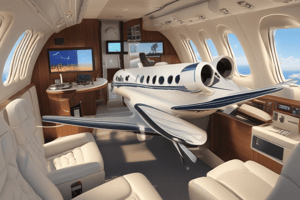Podcast
Questions and Answers
What is the primary purpose of the spoiler control system on the Gulfstream G650ER?
What is the primary purpose of the spoiler control system on the Gulfstream G650ER?
The spoiler control system provides electrical and mechanical control of the spoilers, fault monitoring and annunciation. Spoilers are used for different flight control functions such as assisting the ailerons in roll control and providing speed brake and ground spoiler functions.
How are the spoiler surface movements primarily controlled?
How are the spoiler surface movements primarily controlled?
The spoiler surface movements are primarily controlled by the Flight Control Computers (FCCs). The FCCs transmit command information to the Remote Electronic Units (REUs) located at each actuator.
What is the role of the Backup Flight Control Unit (BFCU) in the spoiler control system?
What is the role of the Backup Flight Control Unit (BFCU) in the spoiler control system?
The BFCU commands only the outboard spoilers for the spoiler function. The BFCU receives inputs only from the control wheel position RVDTs and transmits command information on digital data busses to the outboard spoiler REUs. The BFCU commands are ignored unless there has been a total failure of both FCCs.
What is the purpose of the RVDT position sensors in the spoiler control system?
What is the purpose of the RVDT position sensors in the spoiler control system?
How is data transmitted between the FCCs and the REUs in the spoiler control system?
How is data transmitted between the FCCs and the REUs in the spoiler control system?
What is the purpose of the electrical backup hydraulic manifold in the spoiler control system?
What is the purpose of the electrical backup hydraulic manifold in the spoiler control system?
Describe the hydraulic actuator manifold in the spoiler control system.
Describe the hydraulic actuator manifold in the spoiler control system.
How does the actuator control system work in the spoiler control system?
How does the actuator control system work in the spoiler control system?
Describe the role of the spoiler control system electronics.
Describe the role of the spoiler control system electronics.
What is the role of the modular avionics units in the spoiler control system?
What is the role of the modular avionics units in the spoiler control system?
Flashcards are hidden until you start studying
Study Notes
Spoiler Control System Overview
- Control inputs for spoiler movement come from pilot and copilot control wheels via RVDT (Rotary Variable Differential Transformer) position sensors.
- RVDT sensors relay data to Flight Control Computers (FCCs) and the Brake and Function Control Unit (BFCU).
- FCCs and BFCU send commands to Remote Electronics Units (REUs) that control hydraulic actuators for spoiler movement.
- Spoiler movements are primarily directed by FCCs through BD429 digital data buses connecting to the REUs.
Inputs and Communication
- FCCs gather inputs from multiple systems including:
- Control wheel position RVDTs
- Speed brake handle RVDTs
- Spoiler ARM switch
- Flap override switch
- Each FCC transmits four independent BD429 buses to the spoiler REUs, resulting in eight independent control buses for the spoilers.
- BFCU provides two ARINC 429 buses specifically for outboard spoiler EBHA REUs, excluding input for EHSA REUs.
Backup Systems and Failures
- In case of failure of both outboard flight spoiler REUs, the MCE (Motor Controller Electronics) bus allows FCCs to maintain control by directing commands to the MCE.
- Typically, MCE is governed directly by the associated EBHA REU, but can operate in electrical backup mode to control the EBHA motor.
Subsystems of the Spoiler Control System
- Key subsystems include:
- Spoiler Interface and Control - details on how pilot and copilot control inputs interface with the system.
- Spoiler Actuation - describes the mechanics of how spoilers are physically moved.
- Spoiler System Electronics - elucidates electronic components involved in spoiler control.
Ground Spoiler Deployment
- Ground spoiler deployment is managed by FCCs, with automatic activation occurring at:
- Landing touchdown
- Aborted takeoff, contingent upon satisfaction of specific deployment conditions.
Studying That Suits You
Use AI to generate personalized quizzes and flashcards to suit your learning preferences.




